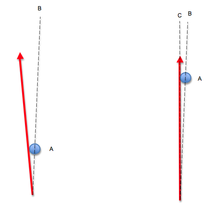Archer's paradox ?
Not to be confused with Zeno's arrow paradox.
Arrow direction when braced and when at full draw. A = bow riser/grip, B
= median plane of the bow, C = arrow aiming line and trajectory
Arrow flexing around the riser of a bow.
The term was first used by E.J. Rendtroff in 1913,[1] and as understanding was gained about the arrow flexing out of the way of the bow as it is shot (as first filmed by Clarence Hickman)[2][3] and then experiencing oscillating back-and-forth bending as it travels toward the target,[4] this dynamic flexing has incorrectly become a common usage of the term, causing misunderstanding by those only familiar with modern target bows, which being 'centre shot' do not actually show any paradoxical behaviour as the arrow is always pointing visually along its line of flight.[5][6][7]
More here.



No comments:
Post a Comment